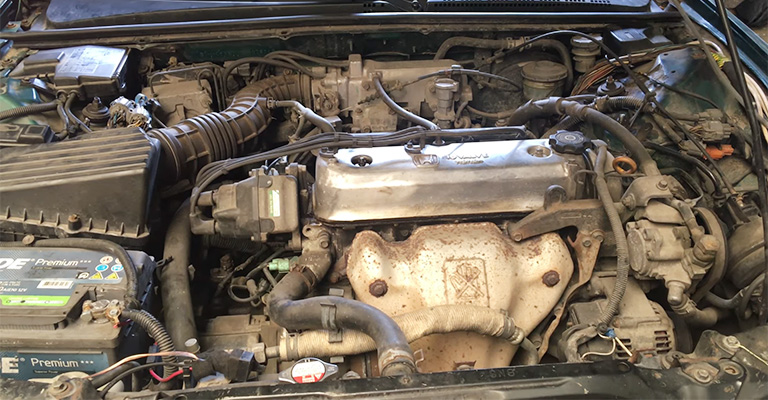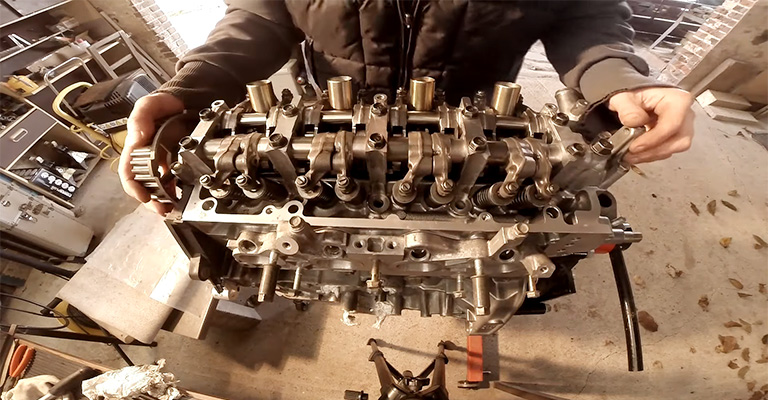The Honda D17A7 engine is a compact and fuel-efficient power plant found in the 2001-2005 Honda Civic GX.
Understanding the specs and performance of a car’s engine is crucial for car enthusiasts and owners as it can greatly impact the driving experience and overall satisfaction with the vehicle.
In this blog post, we will provide a detailed overview of the Honda D17A7 engine and its key features, and evaluate its performance to help you make an informed decision.
Whether you are a car enthusiast, owner, or just considering purchasing a Honda Civic GX, this article will give you a comprehensive understanding of the Honda D17A7 engine.

Honda D17A7 Engine Overview
The Honda D17A7 engine is a 1.7-liter, 4-cylinder engine that was introduced in the 2001-2005 Honda Civic GX. It is designed to run on compressed natural gas (CNG), which is a clean-burning and cost-effective alternative to gasoline.
The engine features a bore and stroke of 75 mm x 94.4 mm, with a compression ratio of 12.5:1. The D17A7 engine is equipped with single overhead cam (SOHC) design,
featuring 4 valves per cylinder, and is equipped with OBD-2 multi-point fuel injection system for improved fuel efficiency and emissions control.
In terms of performance, the Honda D17A7 engine produces 100 horsepower at 6,100 rpm and 98 lb-ft of torque at 4,000 rpm. These outputs are impressive for a compact engine of its size and type, providing a smooth and responsive driving experience.
The engine’s fuel efficiency is also improved by its use of CNG, which has a higher energy density compared to gasoline and produces fewer emissions.
The Honda D17A7 engine is known for its reliability, durability, and low maintenance costs. It is designed to provide a cost-effective alternative to traditional gasoline engines, without sacrificing performance or efficiency.
Additionally, the use of CNG as fuel can result in substantial cost savings, as CNG is often less expensive than gasoline.
Overall, the Honda D17A7 engine is a well-rounded and capable power plant, offering a combination of performance, efficiency, and cost-effectiveness.
Whether you are a car enthusiast, owner, or just considering purchasing a Honda Civic GX, it is worth taking the time to understand the specs and performance of the D17A7 engine to make an informed decision.

Specification Table for D17A7 Engine
| Specification | Value |
| Engine Model | D17A7 |
| Years Produced | 2001-2005 |
| Vehicle Model | Honda Civic GX |
| Fuel Type | Compressed Natural Gas (CNG) |
| Displacement | 1,668 cc |
| Bore and Stroke | 75 mm x 94.4 mm |
| Compression Ratio | 12.5:1 |
| Valve Train | SOHC, 4 valves per cylinder |
| Fuel Control | OBD-2 MPFI |
| Power Output | 100 hp at 6,100 rpm |
| Torque Output | 98 lb-ft at 4,000 rpm |
Source: Wikipedia
Comparison With Other D17 Family Engine Like D17A1 and D17A2
The Honda D17A7 engine is part of the D17 engine family, which includes several other engines such as the D17A1 and D17A2.
Here is a comparison of the key specs between these engines
| Engine Model | D17A1 | D17A2 | D17A7 |
| Years Produced | 2001-2005 | 2001-2005 | 2001-2005 |
| Vehicle Model | Honda Civic LX/EX | Honda Civic LX/EX | Honda Civic GX |
| Fuel Type | Gasoline | Gasoline | Compressed Natural Gas (CNG) |
| Displacement | 1,668 cc | 1,668 cc | 1,668 cc |
| Bore and Stroke | 75 mm x 84.0 mm | 75 mm x 94.4 mm | 75 mm x 94.4 mm |
| Compression Ratio | 9.7:1 | 10.0:1 | 12.5:1 |
| Valve Train | SOHC, 4 valves per cylinder | SOHC, 4 valves per cylinder | SOHC, 4 valves per cylinder |
| Fuel Control | OBD-2 PGM-FI | OBD-2 PGM-FI | OBD-2 MPFI |
| Power Output | 115 hp at 6,200 rpm | 126 hp at 6,200 rpm | 100 hp at 6,100 rpm |
| Torque Output | 109 lb-ft at 5,000 rpm | 106 lb-ft at 5,800 rpm | 98 lb-ft at 4,000 rpm |
As you can see, the D17A7 engine differs from the D17A1 and D17A2 in several key areas. The D17A7 is designed to run on compressed natural gas (CNG), while the D17A1 and D17A2 run on gasoline.
The D17A7 has a higher compression ratio and slightly lower power output compared to the D17A1 and D17A2, but provides improved fuel efficiency and lower emissions due to its use of CNG.
Additionally, the D17A7 has a different fuel control system (OBD-2 MPFI) compared to the D17A1 and D17A2 (OBD-2 PGM-FI).
Overall, the Honda D17 engine family provides a range of engine options for different vehicles and driving needs.
The D17A7 engine provides a cost-effective and environmentally friendly alternative to traditional gasoline engines, making it a great choice for car owners who are looking for a reliable and fuel-efficient power plant.
Head and Valvetrain Specs D17A7
The Honda D17A7 engine features a Single Overhead Cam (SOHC) valvetrain design, which means that there is one camshaft located above the cylinders that operates the engine’s valves.
This design is simple, reliable, and cost-effective, making it a popular choice for many engines.
Each cylinder in the D17A7 engine has four valves, which provides improved breathing and better combustion compared to engines with fewer valves.
This results in increased power, improved fuel efficiency, and reduced emissions.
The SOHC valvetrain design, combined with the 4-valve per cylinder configuration, provides a high-performing engine that is easy to maintain and service.
The D17A7 engine is an excellent choice for car enthusiasts and owners who are looking for an engine with solid performance, efficiency, and reliability.
The Technologies Used in
The Honda D17A7 engine incorporates several technologies to improve its performance, efficiency, and reliability.
Some of the key technologies used in the D17A7 engine include
1. Compressed Natural Gas (CNG) Fuel System
The D17A7 engine is designed to run on compressed natural gas (CNG), which is a cleaner and more environmentally friendly alternative to gasoline. The CNG fuel system provides improved fuel efficiency and reduced emissions compared to traditional gasoline engines.
2. Multi-Point Fuel Injection (MPFI)
The D17A7 engine uses a multi-point fuel injection (MPFI) system to ensure precise fuel delivery and efficient combustion. The MPFI system provides improved fuel economy, reduced emissions, and smoother engine performance compared to carbureted engines.
3. OBD-2 Engine Management System
The D17A7 engine features an On-Board Diagnostics (OBD-2) engine management system, which provides real-time monitoring and control of the engine’s performance. This system helps to improve fuel efficiency and reduce emissions, while also providing an early warning of any potential engine issues.
4. High Compression Ratio
The D17A7 engine has a high compression ratio of 12.5:1, which provides improved fuel efficiency and increased power output compared to engines with lower compression ratios.
The high compression ratio also helps to reduce emissions and improve combustion efficiency.
Overall, the Honda D17A7 engine is a technologically advanced power plant that provides excellent performance, efficiency, and reliability.
These technologies make the D17A7 engine a great choice for car enthusiasts and owners who are looking for a fuel-efficient and environmentally friendly engine.
Performance Review
The Honda D17A7 engine delivers solid performance in a compact and efficient package. With 100 horsepower and 98 lb-ft of torque, the D17A7 provides ample power for daily driving and light to medium-duty tasks.
The engine’s high compression ratio, multi-point fuel injection, and OBD-2 engine management system all contribute to its smooth and efficient performance. The engine starts easily and delivers smooth, consistent power across the rev range.
The D17A7 engine is also very fuel efficient, providing excellent fuel economy for a naturally aspirated engine of its size.
The D17A7’s single overhead cam valvetrain provides a good balance between performance and simplicity, making it an easy engine to maintain and service.
The engine’s four-valve per cylinder configuration provides improved breathing and combustion compared to engines with fewer valves, and the high compression ratio provides increased power output and fuel efficiency.
Overall, the Honda D17A7 engine is a solid performer that provides excellent fuel efficiency, reliability, and durability.
The engine is an excellent choice for car enthusiasts and owners who are looking for an engine that provides good performance, efficiency, and reliability in a compact and efficient package.
What Car Did the D17A7 Come in?
The Honda D17A7 engine was primarily found in the 2001-2005 Honda Civic GX. The Civic GX was a natural gas-powered version of the popular Honda Civic compact car, and was equipped with the D17A7 engine to provide clean and efficient performance.
The D17A7 engine was designed specifically to run on compressed natural gas (CNG) and was well-regarded for its fuel efficiency, reliability, and low emissions.
The Civic GX with the D17A7 engine remains a popular choice among environmentally conscious car buyers, and is still in use today as a reliable and efficient transportation solution.
D17A7 Engine Most Common Problems
The D17A7 engine, commonly used in the Honda Civic, can experience the following problems
- Oil leaks
- Engine misfires
- Valve tapping or lifter noise
- Excessive oil consumption
- Engine knocking or pinging
- Engine stalling or not starting
- Poor fuel efficiency
- Engine hesitation or surging
- Camshaft timing chain tensioner failure
- Engine management system faults.
It’s recommended to keep up with regular maintenance, including oil changes and checking for leaks, to prevent potential issues and keep the engine running smoothly. In case of any problems, it’s best to consult a professional mechanic for proper diagnosis and repairs.
Other D Series Engines-

Leave a Reply